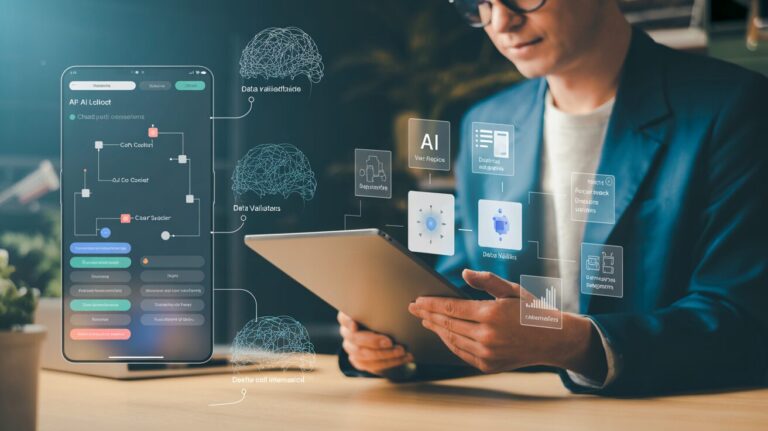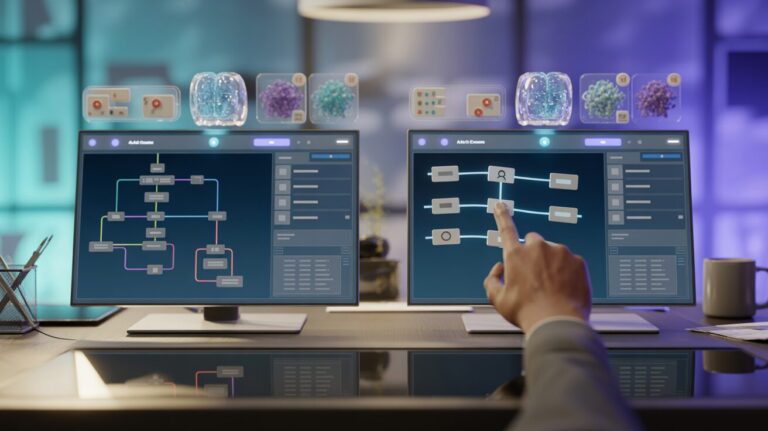Table of Contents
- Understanding AI Chatbot Builders
- How AI Chatbot Builders Work
- Key Features of AI Chatbot Builders
- Types of AI Chatbots You Can Create
- Benefits of Using AI Chatbot Builders
- No-Code vs. Traditional Development
- Getting Started with an AI Chatbot Builder
- Common Challenges and Solutions
- Future of AI Chatbot Technology
Imagine having an intelligent assistant that can engage with your website visitors, answer customer questions, provide personalized recommendations, or even help streamline your internal business processes—all without requiring your constant attention. This isn’t science fiction; it’s the reality of modern AI chatbots.
In recent years, chatbot technology has evolved dramatically, transforming from simple rule-based programs into sophisticated AI-powered conversational agents capable of understanding natural language, learning from interactions, and providing increasingly human-like responses. But until recently, creating these powerful tools required extensive coding knowledge and AI expertise.
That’s where AI chatbot builders come in. These innovative platforms have democratized chatbot creation, making it possible for anyone—regardless of technical background—to build, deploy, and manage intelligent chatbots. Whether you’re a small business owner looking to improve customer service, a content creator wanting to engage with your audience in new ways, or an educator seeking interactive learning tools, AI chatbot builders put this powerful technology within your reach.
In this comprehensive guide, we’ll explore everything you need to know about AI chatbot builders, from fundamental concepts to practical applications. You’ll discover how these platforms work, what types of chatbots you can create, and how to get started building your own AI assistant—even if you’ve never written a line of code.
AI Chatbot Builders at a Glance
Everything you need to know about creating AI chatbots without coding
What Are AI Chatbot Builders?
Specialized platforms that enable anyone to create conversational AI applications without programming skills, using intuitive visual interfaces instead of code.
Evolution of Chatbots
- 1st Gen: Rule-based with limited, scripted responses
- 2nd Gen: NLP-powered with better language understanding
- 3rd Gen: Advanced AI using large language models (LLMs)
Key Technologies Behind AI Chatbots
NLP
Enables understanding of human language regardless of phrasing
Machine Learning
Helps chatbots improve from conversations and feedback
LLMs
Power human-like responses using models like GPT-4
Knowledge Bases
Structured information repositories for accurate answers
Types of Chatbots You Can Create
Customer Service
Handle inquiries and troubleshoot issues
Lead Generation
Engage visitors and collect contact info
Educational
Teach concepts and provide explanations
Expert Advisors
Provide domain-specific expertise
Business Benefits
- 24/7 customer support without staffing costs
- Reduced operational costs through automation
- Scalable to handle thousands of conversations
- Consistent information and service quality
- Valuable data collection and insights
Getting Started with AI Chatbot Builders
Define Your Purpose
Clearly identify what your chatbot should achieve
Map Conversations
Outline key conversation flows and user questions
Choose a Platform
Select a no-code builder like Estha that fits your needs
Import Knowledge
Add the information your chatbot will use
Test & Deploy
Validate performance and launch your chatbot
Monitor & Improve
Use analytics to continuously enhance performance
No-Code vs. Traditional Development
No-Code Platforms
- Minutes/days to build vs. months
- No technical expertise required
- Lower upfront and maintenance costs
- Automatic updates and improvements
- Quick iteration based on feedback
Traditional Development
- Maximum flexibility and customization
- Requires developers, data scientists, UX designers
- Higher costs (tens of thousands of dollars)
- Manual maintenance and updates
- Suitable for highly specialized use cases
Understanding AI Chatbot Builders
AI chatbot builders are specialized platforms that enable users to create, customize, and deploy conversational AI applications without requiring programming skills. These tools provide intuitive interfaces where users can define their chatbot’s functionality, knowledge base, and conversational flows through visual elements rather than code.
At their core, AI chatbot builders are about accessibility. They abstract away the complex technical components of natural language processing, machine learning, and conversational design, allowing users to focus on what matters most: creating helpful, engaging AI experiences that serve specific purposes.
Modern AI chatbot builders typically offer a range of capabilities, from simple decision-tree chat flows to sophisticated AI assistants that can understand context, remember previous interactions, and continuously learn from conversations. The most advanced platforms, like Estha, even allow users to create custom AI applications that go beyond simple chatbots to become specialized virtual experts in particular domains.
Evolution of Chatbot Technology
Chatbots have come a long way since their early days. The evolution can be broadly categorized into three generations:
First Generation: Rule-based chatbots that follow pre-determined scripted paths and can only respond to specific commands or questions. These were limited by their inability to understand variations in human language.
Second Generation: AI-powered chatbots using natural language processing (NLP) that can understand intent and respond more naturally to a wider range of queries, but still primarily follow programmed paths.
Third Generation: Advanced AI chatbots built on large language models (LLMs) like GPT-4, which can understand context, generate human-like responses, learn from interactions, and handle complex conversations much more effectively.
Today’s no-code AI chatbot builders typically leverage these third-generation capabilities while making them accessible through visual interfaces. This represents a significant democratization of AI technology, putting powerful tools previously available only to technical specialists into the hands of everyday users across all industries.
How AI Chatbot Builders Work
Understanding the inner workings of AI chatbot builders can help you make better decisions when creating your own chatbots. While the technical details can be complex, the fundamental process follows these general principles:
Underlying Technologies
Most modern AI chatbot builders rely on several key technologies:
Natural Language Processing (NLP): This allows chatbots to understand human language, including the intent behind questions and statements. NLP enables chatbots to extract meaning from text regardless of how a question is phrased.
Machine Learning: This helps chatbots improve over time by learning from conversations and feedback. The more interactions a chatbot has, the better it becomes at providing relevant responses.
Large Language Models (LLMs): Modern chatbots often leverage powerful pre-trained models like GPT-4, which have been trained on vast amounts of text data and can generate remarkably human-like responses.
Knowledge Bases: These are structured repositories of information that chatbots can reference when answering questions, ensuring accuracy and relevance in specialized domains.
The No-Code Approach
What sets modern chatbot builders apart is their no-code approach. Instead of requiring users to write complex algorithms or train AI models, these platforms provide visual interfaces where users can:
Define conversation flows: Using visual diagrams, drag-and-drop elements, or simple configuration options to map out how conversations should progress.
Import knowledge: Uploading documents, connecting to databases, or manually entering information that forms the chatbot’s knowledge base.
Customize behavior: Setting personality parameters, response styles, and interaction patterns without coding.
Test and refine: Using built-in simulators to test conversations and make adjustments in real-time.
For example, Estha’s platform uses an intuitive drag-drop-link interface that allows users to build complex AI applications in minutes. This approach means that a small business owner can create a customer service chatbot, a teacher can build an interactive learning assistant, or a healthcare professional can develop a patient education tool—all without writing a single line of code.
Key Features of AI Chatbot Builders
When evaluating AI chatbot builders, several key features distinguish the most capable platforms from basic solutions. Understanding these components will help you choose the right platform for your needs:
Essential Capabilities
Visual Design Interface: Effective platforms offer intuitive visual editors where you can design conversation flows without coding. The best interfaces make it easy to map out complex interactions through simple drag-and-drop operations.
Customization Options: Look for platforms that allow you to customize your chatbot’s personality, tone, language style, and visual appearance to match your brand identity.
Knowledge Management: Strong chatbot builders provide ways to easily import, organize, and update the information your chatbot will use when responding to questions.
Multi-channel Deployment: The ability to deploy your chatbot across various platforms—website, mobile app, social media, messaging services—from a single interface saves significant time and effort.
Analytics and Reporting: Comprehensive analytics help you understand how users interact with your chatbot, what questions are most common, and where improvements are needed.
Advanced Features
Integration Capabilities: Superior platforms allow integration with CRM systems, help desks, payment processors, and other business tools to create seamless user experiences.
Contextual Understanding: Advanced chatbots maintain context throughout conversations, remembering previous interactions and using that information to provide more relevant responses.
Learning and Improvement: The best chatbots continuously improve through machine learning, analyzing conversations to enhance future interactions.
Human Handoff: For situations where AI assistance isn’t sufficient, some platforms offer smooth transitions to human operators.
Monetization Options: Some platforms like Estha include features for sharing and monetizing your AI creations, allowing you to potentially generate revenue from your chatbots.
Types of AI Chatbots You Can Create
AI chatbot builders enable the creation of various types of conversational applications, each serving different purposes and use cases:
By Function
Customer Service Chatbots: These handle common customer inquiries, troubleshoot issues, and collect information before escalating to human agents when necessary.
Lead Generation Chatbots: Designed to engage website visitors, qualify prospects, and collect contact information to nurture potential customers.
Educational Chatbots: Interactive learning assistants that can teach concepts, quiz users, provide explanations, and adapt to different learning styles.
Personal Assistant Chatbots: Help users manage tasks, schedule appointments, set reminders, and provide personalized recommendations.
Expert Advisor Chatbots: Specialized chatbots that provide domain-specific expertise in areas like legal advice, health information, financial guidance, or technical support.
By Complexity
Simple FAQ Bots: Answer common questions based on a predefined knowledge base, ideal for addressing straightforward inquiries.
Interactive Flow Bots: Guide users through processes like booking appointments, placing orders, or filling out forms through structured conversation paths.
AI-Powered Conversational Agents: Sophisticated chatbots that understand natural language, maintain context, and provide intelligent responses even to unpredictable queries.
Multi-modal AI Assistants: Advanced assistants that can process and respond to different types of input (text, voice, images) and integrate with various systems to perform complex tasks.
With platforms like Estha, users can create any of these types of chatbots without technical expertise. For example, a healthcare provider might build an expert advisor chatbot to help patients understand treatment options, while a retailer could deploy a customer service chatbot to handle order inquiries and returns.
Benefits of Using AI Chatbot Builders
AI chatbot builders offer numerous advantages for businesses, content creators, educators, and individuals looking to leverage conversational AI technology:
Business Benefits
24/7 Customer Support: Chatbots provide round-the-clock assistance without increasing staffing costs, ensuring customers get help whenever they need it.
Reduced Operational Costs: By automating routine inquiries and processes, chatbots can significantly reduce the workload on human teams, allowing them to focus on more complex issues.
Scalable Customer Interactions: Chatbots can handle thousands of simultaneous conversations, making it easy to scale support operations during peak periods without additional resources.
Consistent User Experience: Unlike human agents who may vary in knowledge and approach, chatbots deliver consistent information and service quality every time.
Data Collection and Insights: Chatbots can gather valuable information about customer needs, preferences, and pain points, providing insights that drive business improvements.
Creator and Personal Benefits
Expanded Reach: Content creators can engage with audiences in new ways, offering interactive experiences that complement traditional content formats.
Knowledge Sharing: Experts can scale their knowledge sharing by creating chatbots that embody their expertise and can interact with many people simultaneously.
Passive Income Potential: With platforms that offer monetization options like Estha, creators can potentially generate revenue from their AI chatbots.
Personal Productivity: Individuals can create personal assistant chatbots tailored to their specific needs and workflows.
Low Barrier to Entry: No-code platforms eliminate the technical barriers that previously prevented non-developers from creating and deploying sophisticated AI applications.
No-Code vs. Traditional Development
Understanding the differences between no-code chatbot builders and traditional development approaches can help you choose the right path for your project:
Comparing Approaches
Development Time: Traditional chatbot development may take months and require a team of developers, data scientists, and UX designers. No-code platforms like Estha can reduce this to days or even minutes.
Technical Requirements: Traditional development demands expertise in programming languages, AI frameworks, and deployment infrastructure. No-code platforms require little to no technical knowledge.
Cost Considerations: Custom development can cost tens of thousands of dollars, while no-code platforms typically operate on subscription models with significantly lower upfront costs.
Flexibility and Control: Custom development offers maximum flexibility but with increased complexity. No-code platforms provide carefully designed frameworks that balance ease of use with customization options.
Maintenance and Updates: Custom-built chatbots require ongoing maintenance and updates by technical teams. No-code platforms handle infrastructure and AI model updates automatically, allowing creators to focus on content and functionality.
When to Choose Each Approach
Choose No-Code When:
• You need to launch quickly with limited resources
• Your requirements align with the capabilities of available platforms
• You don’t have access to specialized technical talent
• You want to test concepts before investing in custom development
• You need to empower non-technical team members to create and maintain chatbots
Choose Traditional Development When:
• You have highly specialized requirements that no platform supports
• You need deep integration with proprietary systems
• Your use case involves unique AI capabilities not available in no-code tools
• You have specific security or compliance requirements that demand custom solutions
• Your organization has the necessary technical resources and budget
For most businesses and individuals, no-code platforms offer the best balance of capabilities, cost, and time-to-market. The rapid evolution of these platforms continuously narrows the gap between what can be achieved with custom development versus no-code solutions.
Getting Started with an AI Chatbot Builder
Ready to create your first AI chatbot? Here’s a step-by-step approach to getting started with an AI chatbot builder:
Planning Your Chatbot
Define Your Purpose: Clearly identify what you want your chatbot to achieve. Is it customer support, lead generation, education, or something else? Having a focused purpose will guide all other decisions.
Identify Your Audience: Consider who will be interacting with your chatbot and what their needs, expectations, and communication preferences might be.
Map Key Conversations: Outline the main types of conversations your chatbot will handle and how they should flow. What questions will users ask? What information will the chatbot need to provide?
Gather Your Knowledge Base: Collect the information your chatbot will need to access—FAQs, product details, how-to guides, policies, or any other relevant content.
Implementation Steps
Choose the Right Platform: Select a chatbot builder that aligns with your needs, considering factors like ease of use, features, deployment options, and pricing. For a completely code-free experience with advanced AI capabilities, platforms like Estha offer an excellent starting point.
Design Your Conversation Flows: Use the platform’s visual editor to map out how conversations will progress. Start with the most common scenarios and gradually expand to cover more edge cases.
Import Your Knowledge: Upload or input the information your chatbot will use to answer questions. Organize this knowledge logically to help the AI find relevant information quickly.
Customize Personality and Appearance: Configure your chatbot’s name, avatar, tone of voice, and visual elements to align with your brand identity.
Test Thoroughly: Before launching, test your chatbot with diverse scenarios to ensure it provides helpful, accurate responses. Use the platform’s testing tools and consider involving real users in beta testing.
Deploy and Promote: Once satisfied with performance, deploy your chatbot to your chosen channels (website, social media, etc.) and let your audience know it’s available to help them.
Monitor and Improve: After launch, regularly review chatbot performance through analytics. Look for common questions it struggles with, points where users abandon conversations, and opportunities to expand its capabilities.
Common Challenges and Solutions
Even with user-friendly AI chatbot builders, you may encounter certain challenges. Here’s how to address some of the most common issues:
Technical and Design Challenges
Challenge: Chatbot Misunderstands User Intents
Solution: Improve the training data by adding more example phrases for each intent. Review conversation logs to identify patterns of misunderstanding and add these variations to your chatbot’s knowledge base.
Challenge: Conversations Feel Unnatural or Robotic
Solution: Refine your chatbot’s personality settings and response templates. Add variation in responses, include conversational phrases, and consider adding appropriate emojis or humor where suitable.
Challenge: Handling Complex Queries
Solution: Implement a clear escalation path for queries beyond the chatbot’s capabilities. This might include offering to connect users with human support or requesting more information to narrow down the issue.
Challenge: Managing Chatbot Knowledge
Solution: Establish a regular schedule for reviewing and updating your chatbot’s knowledge base. Use analytics to identify information gaps that need to be filled.
User Adoption Challenges
Challenge: Users Bypass the Chatbot for Human Support
Solution: Make your chatbot visibly helpful from the first interaction. Clearly communicate what the chatbot can help with and ensure early responses provide immediate value.
Challenge: Low Engagement Rates
Solution: Make your chatbot more proactive by initiating conversations when appropriate. Consider adding interactive elements like buttons, carousels, or quick replies to make interactions easier.
Challenge: Managing User Expectations
Solution: Be transparent about your chatbot’s capabilities and limitations. It’s better to clearly state what the chatbot can help with rather than disappointing users with failed attempts at handling everything.
Remember that building an effective chatbot is an iterative process. The most successful implementations continuously evolve based on user feedback and performance data. Platforms like Estha make this iteration process simple, allowing you to quickly refine your chatbot based on real-world performance.
Future of AI Chatbot Technology
As AI continues to advance at a remarkable pace, chatbot technology is evolving alongside it. Understanding these trends can help you build chatbots that remain relevant and effective:
Emerging Trends
Multimodal Interactions: Future chatbots will seamlessly handle text, voice, images, and video inputs, creating more natural and comprehensive communication experiences.
Emotional Intelligence: Advances in sentiment analysis will enable chatbots to recognize and respond appropriately to user emotions, making conversations feel more empathetic and human.
Personalization at Scale: AI chatbots will increasingly tailor their responses based on individual user history, preferences, and behaviors, delivering truly personalized experiences.
Augmented Intelligence: Rather than replacing human workers, chatbots will increasingly work alongside them, handling routine tasks while seamlessly escalating complex issues to the right human experts.
Cross-Platform Continuity: Conversations will flow naturally across devices and platforms, with chatbots maintaining context regardless of where the interaction occurs.
Preparing for the Future
To ensure your chatbot investments remain valuable as technology evolves:
Choose Adaptable Platforms: Select chatbot builders that continuously update their AI capabilities and provide access to new features as they emerge.
Focus on Value Over Technology: While technological capabilities matter, the most important factor in chatbot success is whether it provides genuine value to users. Even simple chatbots that solve real problems effectively will outperform technically advanced ones that don’t.
Collect and Leverage Data: The conversations your chatbot has today can provide invaluable training data for future improvements. Ensure you’re capturing and analyzing this information appropriately.
Stay Learning-Oriented: The field is evolving rapidly. Follow industry developments, participate in communities, and be prepared to adapt your approach as new best practices emerge.
Platforms like Estha are at the forefront of democratizing access to these advanced capabilities, making it possible for anyone to create AI applications that leverage the latest advancements without requiring specialized technical knowledge.
Conclusion
AI chatbot builders have fundamentally transformed who can create intelligent conversational experiences. What once required teams of developers and data scientists can now be accomplished by anyone with a vision and access to the right platform. This democratization of AI technology opens up tremendous opportunities for businesses, content creators, educators, and innovators across all fields.
As we’ve explored throughout this guide, creating effective chatbots involves more than just the technology—it requires thoughtful planning, careful design, and ongoing refinement based on user interactions. By following the approaches outlined here and leveraging no-code platforms like Estha, you can create chatbots that provide genuine value to your audience while requiring minimal technical expertise.
The future of chatbot technology is bright, with continuous advances making these AI assistants increasingly capable, natural, and helpful. By starting your journey now, you position yourself to take advantage of these innovations as they emerge, building on your experience and continuously enhancing what your chatbots can do.
Whether you’re looking to improve customer service, share specialized knowledge, create interactive learning experiences, or simply explore the possibilities of conversational AI, today’s chatbot builders provide an accessible entry point to this powerful technology. The question is no longer whether you have the technical skills to create AI chatbots, but rather what innovative experiences you’ll build with these new tools at your disposal.
Ready to Build Your Own AI Chatbot?
Create custom AI chatbots and expert advisors in minutes—no coding or AI expertise required.



